Finding a strange animal’s poop in your backyard can be scary. It could be from any number of wild creatures, and identifying it lets you know if it’s dangerous or not.
First, when identifying animal poop in your backyard, don’t touch it, because it could make you sick. Then, take note of its size, a larger poop could come from a bigger animal, like a coyote, raccoon, or bear. Smaller poops might be from rats, snakes, or squirrels. Also, look at the shape of the droppings, they could be tubular, round, or pellets. Next, see if there is undigested food in the poop. Finally, analyze the color to help you identify what animal left it.
Figuring out which animal pooped in your yard will help you take the appropriate steps to deal with them. Keep reading this article for a quick chart of different backyard animal poops and detailed descriptions of each one.
Please see also my articles: “How to Get Rid of Pests in Your Car!” and “How To Deal With Mouse Poop.”
Backyard Animal Poop Identification Chart
| Animal | Shape | Size | Color | Consistency |
|---|---|---|---|---|
| Deer | Pellets | 1/2 to 5/8 inch | Brown or black | Firm |
| Bear | Piles | 5 to 6 inches across | Black, brown, or berry colored | Soft |
| Rabbit | Pellets | 1/8 to 1/2 inch | Brown or black | Firm |
| Squirrel | Oblong or round | 1/4 to 1/2 inch | Brown or black | Soft |
| Raccoon | Tubular or rope-like | 2 to 3 inches long | Dark brown or black | Soft |
| Coyote | Tubular or rope-like | 3 to 4 inches long | Black when fresh, turning gray or white | Firm |
| Snake | Sausage-like | 1/2 to 3 inches long | Black or brown, with a white sections | Soft |
| Skunk | Twisted, tapered at ends | 1/4 to 1/2 inch | Brown or black | Soft |
| Pigeon | Thick liquid | 1 to 2 inches across | White with dark spots | Soft, but dries fast |
| Opossum | Tubular or rope-like | 1 to 2 inches long | Dark brown or black | Soft |
| Rat | Small pellets | 1/8 to 1/4 inch | Dark brown or black | Soft |
| Mouse | Like rice grains | 1/4 inch | Black | Soft |
| Fox | Tubular, tapered at one end | 2 to 3 inches long | Black or brown | Firm |
Identifying Squirrel Poop
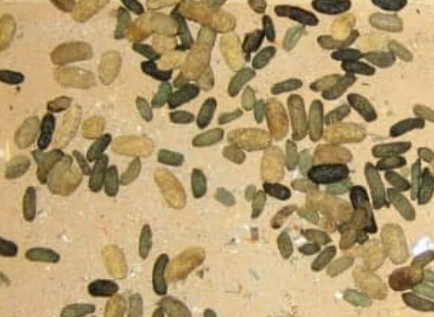
Squirrels are common critters throughout the USA, often seen climbing trees or scavenging in grassy areas. They spread their small poop around their territory, meaning you’re unlikely to notice it in your backyard unless they move into your house.
Squirrel poop size varies but averages about 3/8 inch long and 1/8 inch around. Fresh droppings are oblong, bean-shaped, reddish-brown to darker brown, and turn chalky as they age.
Squirrels don’t poop in their nests. In fact, the momma squirrel removes her baby’s poop from their treetop perch.
Identifying Bear Poop
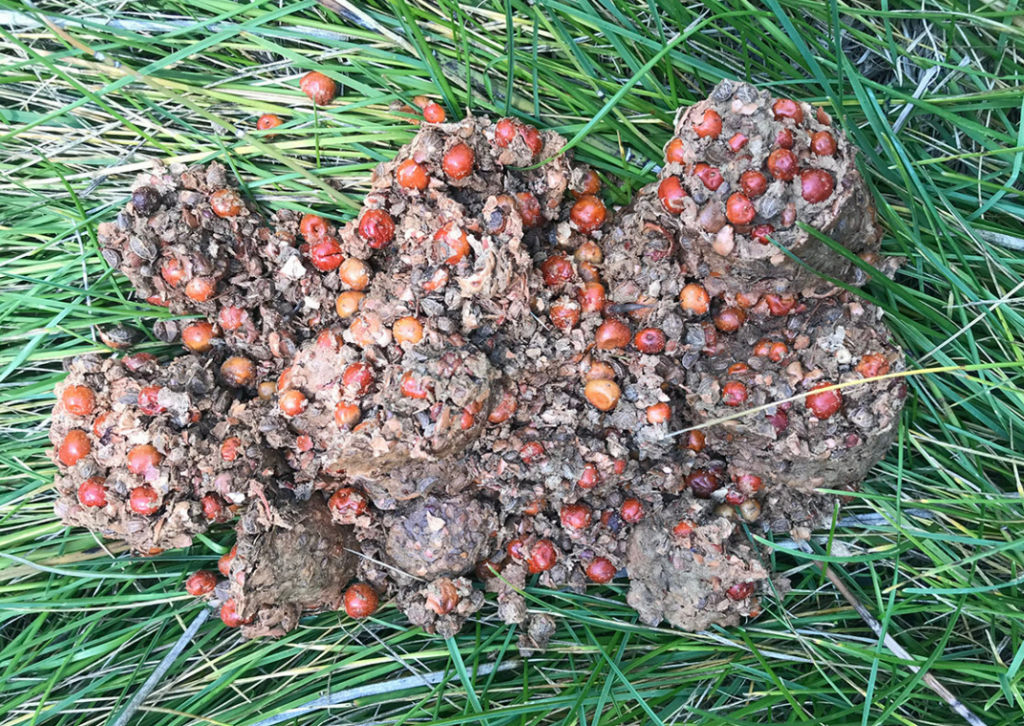
Bear poop comes in large piles about 5-12 inches across and 1 inch tall. They might resemble cow pies, a dirt pile, large dog poop, or donkey droppings.
One of the most noticeable features of bear poop is its contents. Bear scat may contain undigested items, including grasses, berries, nuts, and occasionally small bones or fur from prey.
Overall, these dangerous predators prefer to stay away from humans, but there’s a chance one might wander into your backyard and have a poo. If you find bear scat on your property, get help from your local wildlife department.
What Does Raccoon Poop Look Like?
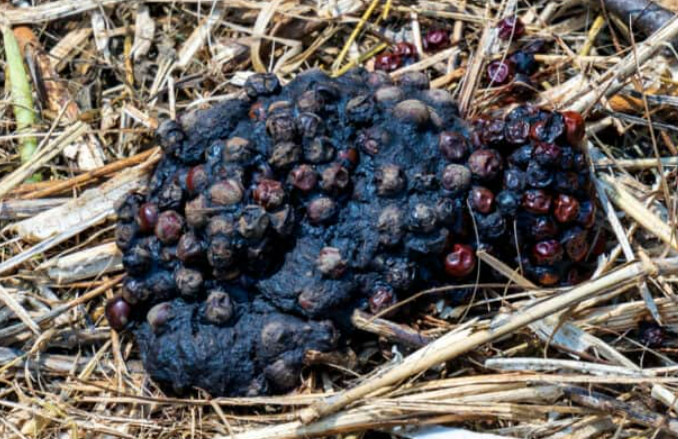
Raccoon droppings are often tubular in shape, similar to a dog’s, with a pronounced tapered end. You may notice raccoon poop in several areas around your backyard, such as near trees or decks where raccoons climb or eat.
The poop is often dark black to brown colored and may contain food remnants like seeds, fur, or bones. The size ranges from 2 to 3 inches long and ½ to ¾ inches in diameter.
Raccoons tend to knock over garbage cans and break into pet food containers to find something to eat. Caution: Raccoon poop can carry diseases and it’s critical to use gloves when cleaning it.
Identifying Deer Poop
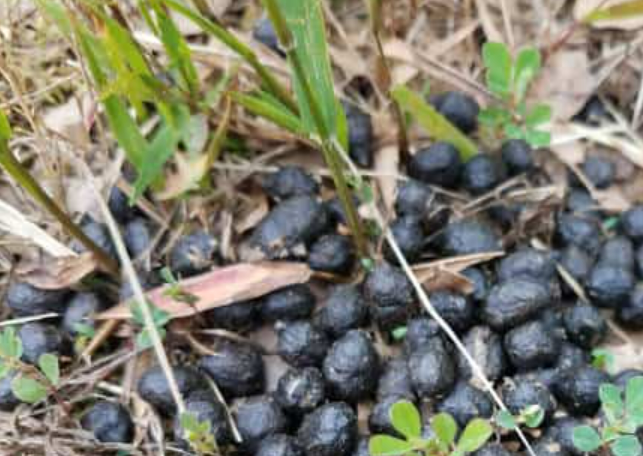
Deer poop, or pellets, are small and ball-shaped. In your backyard, you’ll notice a circular grouping of 20 or more balls where they were dropped.
Deer droppings are dark brown in color and have a textured surface. The pellets are about a half inch in diameter, firm and dry.
Vegetable gardens attract deer, and these animals are becoming more common in some urban areas. Deer poop can carry diseases.
Identifying Coyote Poop
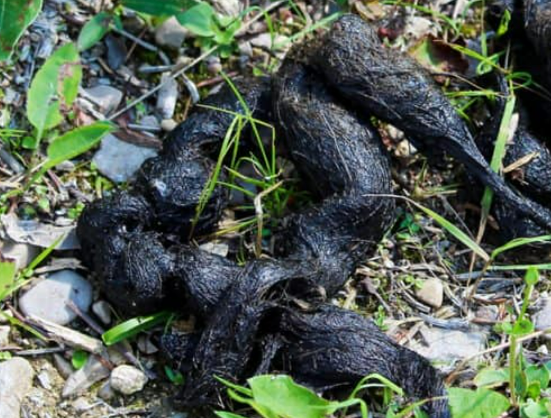
Coyote droppings are usually cylindrical and similar to dog poop, but with long tapered ends. Coyote poop is typically about 1 to 1.5 inches in diameter and 3 to 4 inches long.
The color varies from light brown to dark brown, and the texture can range from firm to loose, depending on the coyote’s diet. You may notice fur, bones, or seeds in the poop.
Coyotes often mark their territory with droppings, so you may notice multiple piles in the same area. These animals are dangerous to pets, and seeing their poop is a warning to guard your furry friends.
Identifying Skunk Poop
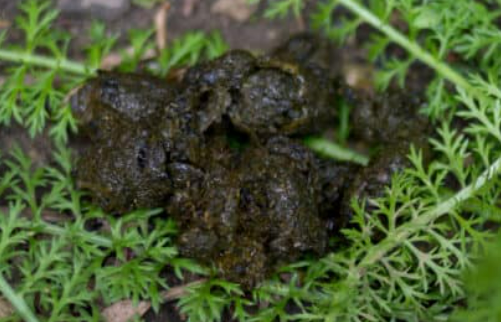
Typically, skunk poop is about the size and shape of a large grape and ranges from 1 to 2 inches long. It’s dark black or brown colored and has a twisted, rope-like appearance with tapered ends.
One of the most distinguishing features of skunk poop is its strong, musky odor. Skunks are notorious for their stinky spray, and their poop has a similar smell that can linger in the area for quite some time.
You might find skunk poop near their den or burrow, which they may create under sheds, decks, or other structures. Keep your distance from skunks, and consider contacting a professional wildlife removal service to safely and humanely remove them from your backyard.
Identifying Rabit Poop
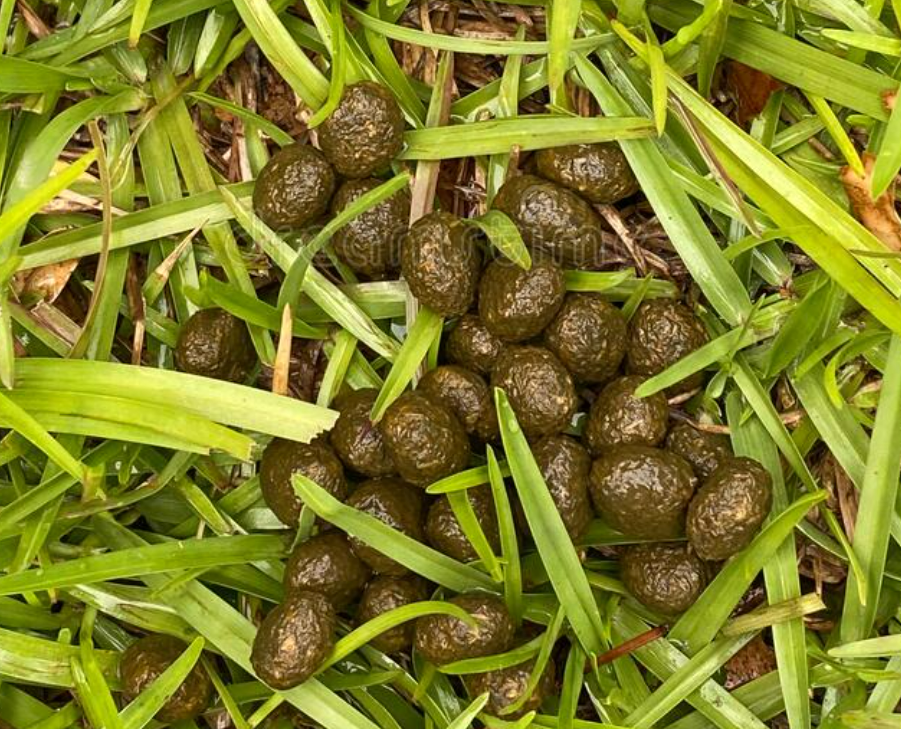
Rabbit poop is round and small, about the size of a chocolate-covered raisin. It’s usually dark brown and has a smooth, shiny surface.
One of the most distinctive features of rabbit poop is its shape. Rabbit droppings are generally cylindrical or oblong, with one end slightly pointed and the other flattened.
Rabbits leave their droppings in piles or clusters, especially near their hiding or feeding areas. While rabbit poop can be annoying, it’s generally harmless and makes a good fertilizer for plants.
Opossum Poop Identification
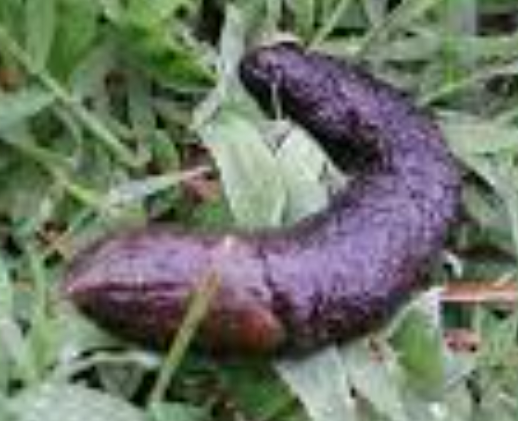
Opossum poop, or scat, is typically the size of a small tootsie roll, about 1-2 inches long. It is dark brown or black and has a pointed end.
Opossum poop might contain undigested food, such as seeds or fruit, which helps you identify the animal’s diet. They can appear in groups of several nuggets clumped together like a single dropping.
While they look scary, opossums are beneficial creatures that eat other pests, including dangerous ticks. Consider contacting a professional wildlife removal service to safely and humanely remove opossums from your property.
Identifying Snake Poop
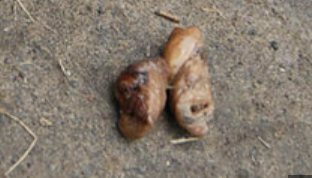
Snake poop varies in appearance depending on the species and its diet. Generally, snake poop is long and cylindrical, like a sausage. It is usually dark brown or black with a white section at the end and may have a glossy, moist appearance when fresh.
The texture of snake poop can also vary depending on the food it has eaten. For example, the feces may contain bone fragments or insect exoskeletons.
How To Identify Rat Poop
Rat droppings are about 1/4 to 1/2 inch long and dark colored. They’re often clustered or grouped because rats repeatedly go to the bathroom in the same spot.
One of the most distinguishing features of rat poop is its shape. These droppings are usually elongated and pointed at both ends, resembling a capsule or a grain of rice.
Also, you might see bits of garbage or nesting material near rat poop. Rats poop close to their travel routes, food sources, or burrows.
Mouse Poop Identification
Mouse poop looks a lot like a rat’s, but smaller at about 1/8 to 1/4 inch long. You’ll often find it in groups, as mice have a habit of pooping in the same location repeatedly.
Mouse droppings look like a grain of rice. Mice poop in various locations, including near food sources, in nests, or along travel routes.
These droppings are some of the most dangerous because they carry the deadly hantavirus. It’s best to leave cleaning mouse poop to professionals, but if you must, read my article about doing it safely here.
Identifying Fox Poop
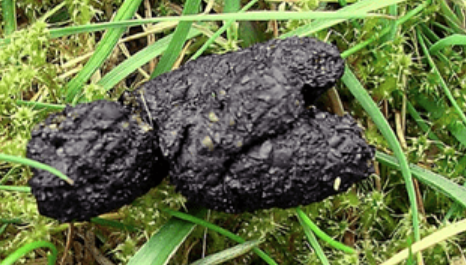
Fox poop is about 2-3 inches long and 1/2 inch around. It’s often twisted or tapered at the ends and may appear segmented. Fox poop may also contain undigested food, such as fur or bone fragments, which can help you identify the animal’s diet.
Foxes are territorial animals and use their scat to mark their base or where they hunt for food. Therefore, seeing their poop in your backyard lets you know they could be scoping out your small pets like rabbits, chickens, or guinea pigs.
Identifying Pigeon Poop
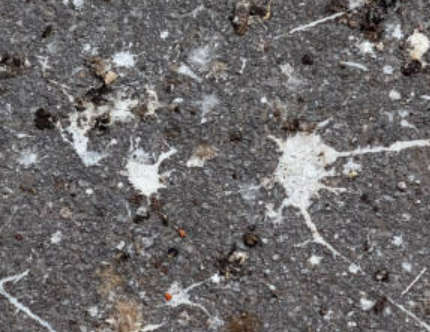
Pigeon poop typically appears as small, white or grayish, round-shaped droppings scattered on pavement, rooftops, or cars. These droppings are mostly white, with green or dark spots.
When fresh, it’s moist and sticky and may smell. Over time, it dries out and hardens, becoming tougher to remove.
While pigeon poop may not pose a direct human health threat, it’s ugly and potentially hazardous if left unattended. It may contain harmful bacteria and parasites that can cause infections, particularly if it comes into contact with open wounds or mucous membranes.